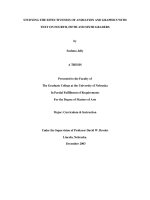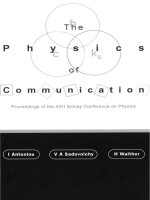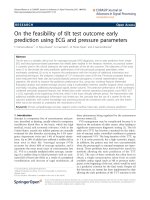Studying the physics of design flow incorporating early information using a simulation model
Bạn đang xem bản rút gọn của tài liệu. Xem và tải ngay bản đầy đủ của tài liệu tại đây (2.12 MB, 290 trang )
STUDYING THE PHYSICS OF DESIGN FLOW
INCORPORATING EARLY INFORMATION USING A
SIMULATION MODEL
MD. ASLAM HOSSAIN
NATIONAL UNIVERSITY OF SINGAPORE
2010
STUDYING THE PHYSICS OF DESIGN FLOW
INCORPORATING EARLY INFORMATION USING A
SIMULATION MODEL
MD. ASLAM HOSSAIN
(B.Sc. in CE, BUET)
A THESIS SUBMITTED
FOR THE DEGREE OF DOCTOR OF PHILOSOPHY
DEPT. OF CIVIL & ENVIRONMENTAL ENGINEERING
NATIONAL UNIVERSITY OF SINGAPORE
2010
National University of Singapore
i
ACKNOWLEDGEMENT
I would like to express my deeply-felt gratitude to my thesis supervisor,
Associate Professor David Kim Haut Chua for his warm encouragement,
continuous support, excellent guidance, constructive suggestions and patience
throughout my PhD study. It would have been impossible to write this thesis
without his invaluable help and time. The immense knowledge and enthusiasm
he has for his research motivated me to do this research and helped me to
overcome various difficulties that I have faced during the PhD pursuit. I
appreciate all his positive advices and problem solving attitude that would
help me in my professional life.
I wish to express my sincere thanks to my PhD committee members Associate
Professor Chin Hoong Chor and Associate Professor Meng Qiang for their
detailed review, constructive criticism and excellent advices during the
preparation of this thesis. I would also like to thank my module lecturers
namely Professor Phoon Kok Kwang, Professor Quek Ser Tong, Associate
Professor Chan Weng Tat, Associate Professor Lee Der-Horng and Dr. Meng
Qiang, along with my PhD supervisor for their teaching and assistance to
complete my module requirements in NUS.
I am deeply grateful to National University of Singapore for providing me
research scholarship covering the inter period of my study.
I wish to thank many industry people who have helped me to gather practical
knowledge on the design process and provided me various design data as the
input for the case study of my research work. I am especially thankful to Dr.
M. Mahalingam, Mr. Jie Zhou, Mr. Siang Meng Kua, Mr. Tan See Chee, and
Mr. David Zheng Zhijian for their valuable time and patience during the
discussion on various aspects of design process.
I wish to extend my warmest thanks to all my colleagues and friends namely
Ker-Wei, Dr. Lijun, Dr. Yuanbin, Dr. Liu Zhuo, Ernest, Yousuf, Alireza,
Habib, Qui, Meghdad, Chun Kit, Bernard, Yi Feng, Kim Thow, Rongxin, Dr.
Ashim, Dr. Shimul, Saidur, Moly for all the emotional support, entertainment,
and caring they provided throughout the study.
Lastly, I owe my most sincere gratitude to my lovely family in Bangladesh
who always stood beside me and encouraged me to complete this thesis. It
would have been very difficult for me to stay in abroad without continuous
encouragement and spiritual support from my family members. My parents,
Late Haji Md. Abdul Jalil and Mrs. Amina Begum have been invaluable to me
throughout my inter study life. My special thanks are due to my brothers, my
sisters and their families for their loving support.
National University of Singapore
ii
National University of Singapore
TBALE OF CONTENTS
ACKNOWLEDGEMENT i
TBALE OF CONTENTS iii
SUMMARY ix
LIST OF TABLES xi
LIST OF FIGURES xiii
LIST OF ABBREVIATIONS xix
LIST OF SYMBOLS xxi
CHAPTER ONE: INTRODUCTION 1
1.1 Introduction 1
1.2 Background 2
1.3 Research Opportunities 3
1.3.1 Early Information in Design 4
1.3.2 Handling Iteration and Feedback Loop 5
1.3.3 External Changes in Design 6
1.3.4 Overlapping Design and Construction Activities 8
1.3.5 Optimal Strategy for overlapping 9
1.3.6 Simulation Model 10
1.4 Objective of the Study 11
1.5 Scope of the Study 12
1.6 Research Methodology 13
1.7 Outline of the Thesis 15
iii
Table of Contents
National University of Singapore
iv
CHAPTER TWO: LITERATURE REVIEW 19
2.1 Introduction 19
2.2 Managing Design Process 20
2.2.1 Some Scheduling Techniques 20
2.3 Overlapping Design Activities 23
2.3.1 Frameworks of Overlapping 24
2.4 Iteration and Feedback Loop in Design 28
2.4.1 Iteration Model for Coupled Activities 29
2.5 Handling External Changes in Design 33
2.6 Design Construction Integration 36
2.7 Simulating Design Process in Construction Industry 42
2.8 Identified Research Gaps 44
2.9 Summary 48
CHAPTER THREE: GENERALIZED MODEL FOR THE DESIGN
PROCESS 49
3.1 Introduction 49
3.2 Generalized AGeM for the Design Process 49
3.3 Developing the Generalized Model for Simulation Network 53
3.3.1 Internal Process 57
3.3.2 Activity Specific and Connecting Nodes 60
3.4 Autogeneration of Specific Design Network 60
3.4.1 Coding for Autogeneration 64
3.5 Validation of the Effectiveness of AGeM 68
3.6 Extension of the Generalized Model 71
Table of Contents
National University of Singapore
v
3.6.1 Resource Constraints 71
3.6.2 Activity Internal Process 76
3.7 Summary 79
CHAPTER FOUR: OVERLAPPING DESIGN ACTIVITIES 81
4.1 Introduction 81
4.2 Early Information Sharing and Redesign 81
4.3 Design Process Model 86
4.3.1 Probability of Redesign 89
4.4 Design Factors Related to Early Information Sharing 91
4.5 Illustrative Case Study 92
4.5.1 Project Characterization 95
4.5.1.1 Effect of Estimability on Project Completion and Loss in
Productivity 95
4.5.1.2 Redesign Duration Vs Estimability 99
4.5.1.3 Project Performance Matrix 103
4.5.1.4 Effect of Probability for Redesign 106
4.6 Summary 107
CHAPTER FIVE: OTHER KEY ISSUES WHEN OVERLAPPING
DESIGN ACTIVITIES 109
5.1 Introduction 109
5.2 ITERATION AND FEEDBACK LOOP IN DESIGN 110
5.2.1 Modeling Iteration and Feedback Loop 111
5.2.1.1 Modeling Loop Through “Repetition” 111
Table of Contents
National University of Singapore
vi
5.2.1.2 Modeling Loop Through “Sit & Settle” 114
5.2.2 Solving Loop through “Repetition” Vs “Sit & Settle” 115
5.2.3 Concluding Remarks for Iteration and Feedback Loop 123
5.3 CHANGE PROPAGATION MODEL DUE TO EXTERNAL
CHANGES 124
5.3.1 Concept of Change Probability and Redesign 124
5.3.2 Modeling Change Propagation 125
5.3.3 Simulation Model for Change Propagation 132
5.3.4 Scheduling Propagated Changes 134
5.3.5 Illustrative Case Study 138
5.3.5.1 Impact on Redesign and Overall Design Schedule 141
5.3.5.2 Concurrent Execution of Design Activities 149
5.3.6 Concluding Remarks to Manage External Changes 156
5.4 INTEGRATION OF DESIGN AND CONSTRUCTION ACTIVITIES
157
5.4.1 Overlapping Design and Construction Activities 157
5.4.2 Integrated Model for Design and Construction 160
5.4.3 Handling Probability of Rework 164
5.4.4 Illustrative Case Study 166
5.4.5 Concluding Remarks for Design Construction Integration 169
5.5 Summary 170
CHAPTER SIX: OPTIMIZING EARLY INFORMATION SHARING
173
6.1 Introduction 173
Table of Contents
National University of Singapore
vii
6.2 Concurrent Engineering Approach 173
6.3 Problem Formulation and Model Development 177
6.4 Search Approach 183
6.5 Integrating GA with DES Model 184
6.6 Illustrative Case Study 186
6.6.1 Results and Analyses 189
6.7 Summary 196
CHAPTER SEVEN: CASE STUDY 199
7.1 Introduction 199
7.2 Description of the Case Study 199
7.2.1 Some Considerations for the Case Study 200
7.3 Results and Discussions 206
7.3.1 Project Characterization 207
7.3.1.1 Effect of Estimability on design duration and redesign 207
7.3.1.2 Variation in Redesign Duration and Estimability 210
7.3.1.3 Project Performance Matrix 212
7.3.2 Consideration for Resource Constraints 216
7.4 Impact of Change on Design Duration and Redesign 218
7.5 Finding an Optimal Strategy of Overlapping 220
7.6 Summary 223
CHAPTER EIGHT: CONCLUSIONS AND RECOMMENDATIONS.225
8.1 Conclusions and Research Contributions 225
8.1.1 Overlapping Design Activities 226
Table of Contents
National University of Singapore
viii
8.1.2 Handling Coupled activities 228
8.1.3 Managing External Changes 230
8.1.4 Overlapping Design and Construction Activities 232
8.1.5 Optimizing Early Information Sharing 233
8.2 Research Significance 235
8.2.1 AGeM of Simulation Network 235
8.2.2 Physics of Design Flow 236
8.2.3 Optimizing Overlapping Strategy 239
8.3 Recommendations and Future Studies 240
8.3.1 Time Cost Tradeoff 240
8.3.2 Optimization of the Design Process 241
8.3.3 Detail Study on Design Construction Integration 243
REFERENCES 245
APPENDICES 259
Appendix A ………………………………………….………………… 261
Appendix B ……………………………………………………………….263
CURRICULUM VITAE 265
National University of Singapore
ix
SUMMARY
Project completion time is of great importance in today’s competitive market. In the
design process, it is common to overlap design activities incorporating early
information from precedent activities to shorten the project duration instead of having
to wait for the confirmed parameter values to arrive after full analysis. However, the
estimated preliminary information might be different from that obtained after the full
analysis. Consequently, redesign may be needed in downstream activities to correct this
discrepancy. Total amount of induced redesign may adversely impact loss in
productivity and overall design completion. Moreover, when utilizing early
information, the impact on redesign is characterized by various design factors such as
number of estimable activities, time to release early information, degree of accuracy of
early information and redesign duration for each activity.
The objective of this study is to achieve a better understanding of the physics of design
flow incorporating early information. The concept of utilizing early information and
redesign has been modeled using the simulation technique. The simulation model
explicitly considers various design factors that characterize the notion of early
information and redesign. Other key issues of design processes such as handling
coupled activities, managing external changes, and overlapping design and construction
activities have been examined incorporating the notion of early information and
redesign.
The design processes have been modeled in generalized way so that the simulation
network can be automatically generated for any design project based on the
dependency relationships of design activities. The framework of the generalized Auto
Generated Model (AGeM) uses the concepts of Activity Specific Nodes and Links to
model the internal processes of design activities, and Connecting Nodes and Links to
model the information flow between activities. Design attributes that make up the
properties of the network are integrated with different arrays that provide significant
flexibility in handling diverse types of workflow in the design process. The templates
of the AGeM are found to be very apt in modeling the design process for any specific
project just by changing the input matrices and form the basis for evaluating the
physics of design flow.
The study characterizes the project performance metrics of design completion and loss
in productivity through sensitivity studies of the parameters of the simulation model.
As can be found, different factors have different impacts on project performance
metrics. Nevertheless, under the right design factors, the use of early information can
be exploited without compromising project performance. As can be found for the case
study, early information sharing from 34 activities (out of 83) can shorten the design
completion from 432 to 303 days (30% reduction) with a loss in productivity of 5% (80
man-days). The reduction could be as high as up to 56% with only 10% loss in
productivity. The sensitivity studies would provide valuable insight that project
managers can take into account when utilizing early information in design. Finally, the
study proposes a framework of systematic overlapping strategy using genetic algorithm
(GA) method. Through Overlapping Strategy Matrix (OSM), the GA model searches
for an optimal combination of design activities to be overlapped eliminating
unnecessary redesign so that the loss in productivity would be minimized. As depicted
in the illustrative case project, optimization can save the loss in productivity as high as
80% without significant delay or even no delay in design completion time. Such
optimization would further encourage project managers to overlap design activities
incorporating early information.
National University of Singapore
x
National University of Singapore
LIST OF TABLES
Table 2.1 DSM in order to show the dependency 22
Table 2.2 Determinants of sensitivity of downstream construction to upstream
design change (taken from Blacud et al. 2009) 41
Table 3.1 Description of design attributes for the case study 69
Table 3.2 Partial Resource Matrix for Process Study activities 75
Table 4.1 DSM for design tasks shown in Figure 4.1 84
Table 4.2 Activity list for the illustrative case study (taken from Gerk and
Qassim 2008) 93
Table 4.3 Total project duration and redesign for variation in activity duration
94
Table 4.4 Total project duration and redesign for different estimability 96
Table 4.5 Comparison of percent reduction in total duration against loss in
productivity for different combination of estimability, estimation time, and
redesign duration for each activity 104
Table 5.1 Activity Dependency with Design Structure Matrix (DSM) 110
Table 5.2 Representing the value of “Influence Factor” for coupled activities
taken from Smith and Eppinger (1997b) 114
Table 5.3 Impact of solution approaches on design duration and loss in
productivity for Different Scenarios of loop 119
Table 5.4 Impact of Influence Factor “IF” between Activities 122
Table 5.5 Transition matrix of probability of change 127
Table 5.6 An illustrative transition matrix 131
Table 5.7 Change propagation in activities ‘c’ and ‘d’ 131
Table 5.8 Impact of change propagation for different degrees of change
initiated in activity 1 146
Table 5.9 Impact of change propagation for different degrees of change
initiated in activity 1 152
Table 5.10 Illustrative case example with design and construction activities167
xi
List of Tables
National University of Singapore
xii
Table 5.11 Impact of overlapping on project completion and construction
rework for different sensitivity and accuracy of design parameters 168
Table 6.1 Comparing overlapping strategies with and without optimization
differing redesign duration for each activity 194
Table 6.2 Comparing overlapping strategies with and without optimization
differing estimation time to release early information 195
Table 7.1 Design activities with various design attributes 202
Table 7.2 Total project duration for ideal condition and considering redesign
with respect to different estimability 208
Table 7.3 Comparison of percent reduction in total duration against loss in
productivity for different combination of estimability, estimation time, and
redesign duration for each activity 213
Table 7.4 Ratio of reduction in total duration against loss of productivity 215
Table 8.1 Influence of four design factors on reduction in total duration and
loss in productivity 227
Table 8.2 Impact of change on design duration, loss in productivity and cut-off
date 232
National University of Singapore
LIST OF FIGURES
Figure 1.1 Flow Chart of the Research Methodology 14
Figure 1.2 Structure of the thesis 16
Figure 2.1 Standard CPM network 21
Figure 2.2 Standard CCM network 21
Figure 2.3 Concept of design evolution rate 24
Figure 2.4 Concept of downstream sensitivity 25
Figure 2.5 Dividing activity based on production rate (taken from Peña-Mora
and Li 2001) 26
Figure 2.6 Interdependent design activities (Taken form Wang et al., 2006) .30
Figure 2.7 Interrelated design changes (taken from Mokhtar et al. 2000) 35
Figure 2.8 Project execution strategies (taken from Maheswari et al. 2006) 38
Figure 3.1 Schematic diagram of the generalized approach to autogenerate the
simulation network 50
Figure 3.2 Flowchart for the generalized internal processed incorporating early
information and redesign 52
Figure 3.3 Generalized simulation network 55
Figure 3.4 Dependencies between each type (‘i’, ‘j’, and ‘k’) of activities and
parameter transmission 57
Figure 3.5 Simulation network for a specific activity 61
Figure 3.6 Partial codes for autogeneration of Activity Specific Nodes and
Links 65
Figure 3.7 Partial codes for autogeneration of Connecting Nodes and Links .66
Figure 3.8 Integrating resource (here specialist) with generalized network 72
Figure 3.9 a) Resource matrix for Activities and specialists; b) Specific
network for CE- specialist with corresponding activities 73
Figure 3.10 Sub-categories of each type (‘i’, ‘j’, and ‘k’) of activity and their
dependencies 76
xiii
List of Figures
National University of Singapore
xiv
Figure 3.11 Simulation network for further sub-categorization of the design
activities 78
Figure 4.1 Parameter dependencies associated with activities 83
Figure 4.2 (a) Traditional finish-start dependency, (b) Early information
sharing with estimation 85
Figure 4.3 Representation of design process for simulation network 87
Figure 4.4 Gantt Chart for the design process without any early estimation 97
Figure 4.5 Gantt Chart for the design process assuming all design tasks are
estimable (i.e. estimability=1) 98
Figure 4.6 Variation in mean and standard deviation due to the variation of
CoV %: (a) Total duration, and (b) Expected redesign for different estimability
100
Figure 4.7 (a) % reduction in total duration, and (b) % of redesign (mandays)
or loss in productivity for different estimability and redesign duration (with
estimation time 40% of the original full analysis) 102
Figure 4.8 Influence of three factors on reduction in total duration and loss in
productivity 105
Figure 4.9 Comparison of project completion time and loss in productivity for
different Degree of Accuracy in estimation (with estimability=0.5 and
estimation time 40% of the original full analysis) 107
Figure 5.1 Modeling Redesign for Coupled Activities if Solved by
“Repetition” 112
Figure 5.2 Modeling Redesign for Coupled Activities if Solved by “Sit and
Settle” 115
Figure 5.3 DSM for Different Design Projects 116
Figure 5.4 Number of Iterations Needed for Activity A
8
to Finalize the Design
120
Figure 5.5 Comparing “Repetition” Vs “Sit and Settle” due to variation in
Influence Factor, Time to do redesign and size of loop 123
Figure 5.6 Probability of change impact in activity ‘b’ due to change in
activity ‘a’ 126
Figure 5.7 “One to one” activity dependency 128
Figure 5.8 Change propagation in multiple dependencies 129
List of Figures
National University of Singapore
xv
Figure 5.9 Simulation model for change propagation: a) “One to one”
dependency, b) Multiple dependencies 133
Figure 5.10 Concurrent execution of design activities with estimated
parameters and the impact of change 135
Figure 5.11 Integrating change propagation model with the scheduling model
136
Figure 5.12 Schematic diagram of the integrated model 137
Figure 5.13 Change propagation due to a change in activity 1: a) Low, b)
Moderate, and c) High degree of changes 139
Figure 5.14 Gantt Chart (with traditional finish-start dependency) for the
design project for a Moderate change initiated in activity 1 on 80
th
week 142
Figure 5.15 Effect of timing of initiated change on the number of activities
affected (a Moderate change is initiated in activities 1 and 10 respectively) 144
Figure 5.16 Impact on design completion time and loss in productivity if a
Moderate change is initiated in activities 1 and 10 respectively 144
Figure 5.17 Comparing impact on design completion time and loss in
productivity for different redesign duration if a Low degree of change is
initiated in activity 1 148
Figure 5.18 Gantt Chart for the design project with concurrent execution of
design activities: a) Before any change is initiated, b) After initiating a High
Degree of change in activity 1 on 40
th
week 150
Figure 5.19 Comparing impact on design completion time for different
redesign duration if a High degree of change is initiated in activity 1 (early
information has been incorporated) 154
Figure 5.20 Comparing impact on loss in productivity for different redesign
duration if a High degree of change is initiated in activity 1 (early information
has been incorporated) 155
Figure 5.21 (a) Traditional Finish-start Dependency, (b) Overlapping design
and construction activities 157
Figure 5.22 Sensitivity of construction activity to the design change 158
Figure 5.23 Concurrent execution of design and construction activities 159
Figure 5.24 Simulation network for design and construction phases 161
Figure 5.25 Dependencies in terms of information transmission 163
List of Figures
National University of Singapore
xvi
Figure 6.1 Bar chart for different scenarios of scheduling 174
Figure 6.2 Forming chromosomes representing the solution 177
Figure 6.3 Flow chart for GA optimization 178
Figure 6.4 Modeling design process with DES 182
Figure 6.5 Overlapping design activities; a) without optimization, b) with
optimization 183
Figure 6.6 Integrated GA and DES model 185
Figure 6.7 Convergence of the performance measurement for the case example
186
Figure 6.8 Sensitivity study for the normalization factor F, (a) impact on
duration, (b) impact on redesign 188
Figure 6.9 Design completion time and loss in productivity for three different
scenarios 189
Figure 6.10 Schedule comparison for two overlapping strategies (without and
with optimization) 191
Figure 6.11 Comparing the probability of redesign for two scenarios of
overlapping 193
Figure 7.1 Gantt Chart for the design process without any early estimation.201
Figure 7.2 Gantt Chart for the design process assuming all design tasks are
estimable (i.e. estimability=1) 209
Figure 7.3 (a) % reduction in total duration, and (b) % of redesign (mandays)
or loss in productivity for different estimability and redesign duration (with
estimation time 40% of the original full analysis) 211
Figure 7.4 Influence of three factors on reduction in total duration and loss in
productivity 214
Figure 7.5 Comparison of project completion time and loss in productivity for
specialist constraints (with estimability=0.5, estimation time 40% of the
original full analysis, and estimation accuracy 50%) 217
Figure 7.6 Impact of change propagation on design duration and redesign due
to a Moderate degree of change initiated in activity 10 219
Figure 7.7 Design completion time and loss in productivity for three different
scenarios (for the case study of 83 activities) 220
List of Figures
National University of Singapore
xvii
Figure 7.8 Comparing the probability of redesign for two scenarios of
overlapping (without and with optimization) 222
Figure 8.1 Comparing two solution approaches of “Repetition” vs “Sit and
Settle” due to variation in Influence Factor, Time to do redesign and size of
loop 230
National University of Singapore
National University of Singapore
xix
LIST OF ABBREVIATIONS
AEC Architecture/Engineering/Construction
AGeM Auto Generated Model
CC Concurrent Construction
CCM Critical Chain Method
CE Concurrent Engineering
CPM Critical Path Method
DA Degree of Accuracy
DES Discrete Event Simulation
DSM Design Structure Matrix
GA Genetic Algorithm
IF Influence Factor
LD Liquidated Damage
OSM Overlapping Strategy Matrix
PERT Program Evaluation and Review Technique
SPS Special Purpose Simulation
National University of Singapore
xx
National University of Singapore
LIST OF SYMBOLS
A
i
i-type activity which has no predecessor
A
j
j-type activity which has both predecessor(s) and successor(s)
A
k
k-type activity which has only predecessor(s) and no successor
A
x
_A
y
Activity A
x
is the predecessor of activity A
y
A
n
n-th activity
A
j
n
n-th activity is j-type
Q Types of design specialist or number of resource pools
T Number of sub-categories of design activities
N
s
Number of simulation run
yx
P
−
Probability of redesign for A
y
due to activity A
x
c
y
P
Combined probability of redesign for activity A
y
x
DA
“Degree of Accuracy” for the estimated parameter of predecessor
activity A
x
r
yx
P
−
Probability of redesign for coupled activity A
y
due to r-th iteration
of coupled activity A
x
x
r
Number of iteration has been done for coupled activity A
x
yx
IF
−
“Influence Factor” for activity A
x
to activity A
y
s
P
Redesign probability for “Sit and settle”
ux
vy
P
,
,
Probability that there is v degree of change in activity ‘y’ due to a
u degree of change in activity ‘x’
N No change
L Low degree of Change
M Moderate degree of change
H High degree of change
xxi
List of Symbols
National University of Singapore
xxii
x
P
Change probability vector for activity ‘x’
ux
P
,
Probability that there is an u degree of change for activity ‘x’
x
y
P
The vector of change probability in activity ‘y’ due to a change in
activity ‘x’
x
y
T
The transition matrix of probabilities of change from ‘x’ to ‘y’
x
vy
P
,
Probability that there is v degree of change in activity ‘y’ due to a
change in activity ‘x’
y
S
The set of predecessor activities of A
y
x
y
PL
Propagation Link from predecessor activity ‘x’ to successor ‘y’
A
d
Design activity
A
c
Construction activity
a
y,x
The row activity a
y
is dependent on the corresponding column
activity a
x
PM Performance Measurement of a project
D Total duration of a project
R Expected amount of redesign or loss in productivity
F Normalization factor for redesign
N
s
Number of simulation run
National University of Singapore
CHAPTER ONE
INTRODUCTION
1.1 Introduction
Time to complete a project is one of the key aspects in today’s competitive
market especially where LD (Liquidated Damages) is very high. In the stages
to realize a project in the AEC (Architecture/Engineering/Construction)
industry, design and construction are of great importance and have been the
areas of much research. Effective design is the prerequisite for the successful
construction of a project.
Research on management of design and engineering in construction projects is
insufficient and needs to be better controlled (Koskela et al., 1997; Rui and
Linying, 2008). Comparatively less attention had been paid on design
management since design phase represents a small portion of the overall cost
of a construction project (Knight and Fayek, 2002). Nevertheless, design
process consumes approximately 22% of project activity time (Moreau and
Back, 2000) and can take several months and years for large projects.
Unplanned design often causes project failure and design defects. Design-
caused errors are the biggest category that affect project delivery time and cost
(Bubshait et al., 1999; Burati et al., 1992). Hence, in the quest of schedule
compression, a comprehensive study on design flow management may
improve the design delivery time and successful implementation in
construction.
1









